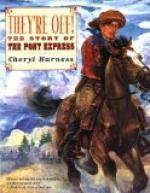In California, the region most benefited by the express, the opening of the line was likewise awaited with the keenest anticipation. Of course there had been at the outset a few dissenting opinions, the gist of the opposing sentiment being that the Indians would make the operation of the route impossible. One newspaper went so far as to say that it was “Simply inviting slaughter upon all the foolhardy young men who had been engaged as riders”. But the California spirit would not down. A vast majority of the people favored the enterprise and clamored for it; and before the express had been long in operation, all classes were united in the conviction that they could not do without it.
At San Francisco and Sacramento, then the two most important towns in the far West, great preparations were made to celebrate the first outgoing and incoming mails. On April 3rd, at the same hour the express started from St. Joseph[4], the eastbound mail was placed on board a steamer at San Francisco and sent up the river, accompanied by an enthusiastic delegation of business men. On the arrival of the pouch and its escort at Sacramento, the capital city, they were greeted with the blare of bands, the firing of guns, and the clanging of gongs. Flags were unfurled and floral decorations lined the streets. That night the first rider for the East, Harry Roff, left the city on a white broncho. He rode the first twenty miles in fifty-nine minutes, changing mounts once. He next took a fresh horse at Folsom and pushed on fifty-five miles farther to Placerville. Here he was relieved by “Boston,” who carried the mail to Friday Station, crossing the Sierras en route. Next came Sam Hamilton who rode through Geneva, Carson City, Dayton, and Reed’s Station to Fort Churchill, seventy-five miles in all. This point, one hundred and eighty-five miles out of Sacramento had been reached in fifteen hours and twenty minutes, in spite of the Sierra Divide where the snow drifts were thirty feet deep and where the Company had to keep a drove of pack mules moving in order to keep the passageway clear. From Fort Churchill into Ruby Valley went H. J. Faust; from Ruby Valley to Shell Creek the courier was “Josh” Perkins; then came Jim Gentry who carried the mail to Deep Creek, and he was followed by “Let” Huntington who pushed on to Simpson’s Springs. From Simpson’s to Camp Floyd rode John Fisher, and from the latter place Major Egan carried the mail into Salt Lake City, arriving April 7, at 11:45 P. M.[5] The obstacles to fast travel had been numerous because of snow in the mountains, and stormy spring weather with its attendant discomfort and bad going. Yet the schedule had been maintained, and the last seventy-five miles into Salt Lake City had been ridden in five hours and fifteen minutes.
At that time Placerville and Carson City were the terminals of a local telegraph line. News had been flashed back from Carson on April 4 that the rider had passed that point safely. After that came an anxious wait until April 12 when the arrival of the west-bound express announced that all was well.




